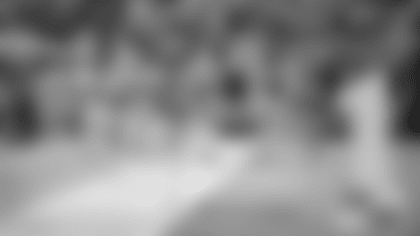Offensive coordinator Jeff Jagodzinski admits he's impatient himself at times, but to anyone who has asked about the progress of the Packers' new zone-blocking scheme, he has insisted it's just a matter of time before the holes, and production of the run game, will come.
That time may have begun to arrive last Sunday.
Against the St. Louis Rams, the Packers offensive line had perhaps its best day with the zone blocking, consistently opening up holes for Noah Herron to rush 20 times for 106 yards. His 5.3-yard average per carry was the Packers' highest for a featured back over the past four games by a yard-and-a-half.
"I've been telling you guys from week to week to week it's getting better and better and better," Jagodzinski told a group of reporters earlier this week. "We're going to continue to get better, and it's going to get faster, and it's going to get more fundamentally sound.
"There were some nice holes, the guys did a nice job up front, run-blocking (Sunday). But that's what we do. I told you guys it's going to come along, and it's starting to."
The ground game had shown its potential here and there over the past month, but the per-carry averages of a banged-up Ahman Green (2.6 vs. New Orleans, 2.9 at Detroit) and Vernand Morency (3.8 at Philadelphia) showed inconsistent production that the offense knew could improve. Green's 5.5-yard average in the season opener is the year's best, but nearly half of his 110 yards against Chicago came in the fourth quarter with the game out of reach.
Herron, who took over for Morency in the first quarter Sunday after a pair of fumbles, deserves some credit but clearly benefited from better blocking than the other backs.
The zone-blocking scheme has essentially two components - to get a push off the line of scrimmage on the side the running back is heading (what is called "stretching the front side"), and using cut blocks to take down the defenders pursuing from behind (or "cutting the backside").
The backside cut-blocking struggled considerably in the season's first two games, but additional drills and emphasis in practice has helped all the linemen become more proficient at the skill.
The biggest improvement last Sunday specifically was with the front side, where Herron had noticeable holes to hit, and he took advantage. A particularly impressive showing came on the Packers' first-quarter touchdown drive, when he had consecutive carries of 9, 11 and 7 yards, all off the left side.
"The more time we spend together in the system, the longer we run it, the better we're getting at it," rookie left guard Daryn Colledge said. "It's just a matter of us wanting to improve every single week, and we have."
Several offensive linemen have talked about getting more comfortable with one another, and that chemistry is contributing to, if not leading, the steady improvement.
"It's just getting used to each other," veteran tackle Mark Tauscher said. "We're getting more and more confident that guys are going to be where they're supposed to be. Trust and confidence is a big thing in this system."
Now the challenge is to maintain the momentum from last Sunday's performance through the bye week and into the rest of the season.
Despite the solid effort, the run-blocking unit wasn't satisfied by any means, and not just because the game didn't end in a victory.
"I think we can get a lot better," Colledge said. "We feel like we left a lot of yards out there on the field against St. Louis, so hopefully we can carry that over into the following week and keep going."
Jagodzinski, for one, will insist upon it.
"We need to keep improving now from this performance to the next one and the next one and the next one," Jagodzinski said. "And we will."
Jagodzinski says that with the same confidence that could be heard in his voice a few weeks ago. It makes it difficult not to believe him.
"What we need to do now is not take a step back but keep moving forward," he said. "(Sunday) needs to be the norm rather than the exception right there."














